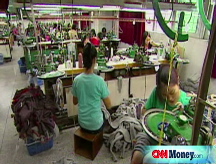Factory orders fall more than expected
Government says demand for manufactured goods falls 2.5% in September.
NEW YORK (CNNMoney.com) -- New factory orders fell more than expected in September, marking the second decline in a row, the government announced Tuesday.
The U.S. Census Bureau said orders fell 2.5% to $432 billion in September, a steeper drop than the 0.8% forecasted by a Briefing.com survey of economists.
The month of August was revised to reflect a greater decline, to 4.3%.
The main source of weakness in the report comes from disruptions to refineries due to Hurricane Ike in September and the falling price of petroleum, according to Mark Vitner, senior economist at Wachovia.
"This report is not as bad as meets the eye," Vitner said. "Because refineries were shut down, they couldn't take orders. Also, the price of petroleum plummeted in September, reducing the dollar values of orders," Vitner said.
According to the report, the value of manufacturers' shipments for petroleum refineries fell 17.5% in September, following an 8.7% drop in August, and a 0.5% drop in July.
Excluding transportation, orders fell 3.7%, the largest percent decrease since data was reported in 1992.
Shipments fell for the second month in a row, dropping 2.8%, or $12.5 billion, to $432.9 billion. That followed a 3.7% decrease in August. For the year, shipments are up 5.9%.
Unfilled orders are at the highest levels since the the data was reported in 1992. They increased 0.4%, or $3.0 billion, to $829.5 billion, and following a 0.3% August increase.
That is some cause for optimism, Vitner said. "It's a very good thing to have a backlog of work, so that even if orders fall off, there's a back log to keep them operating," he said.
Inventories are down 0.7%, to $558.7 billion, down following four consecutive monthly increases. In August, inventories reported a 0.7% August increase.
Durable goods, which make up more than half of the factory orders report, was revised up to 0.9% from the report issued last week. That brings new orders for manufactured durable goods up $1.8 billion to $207.9 billion, following a 5.5% decrease in August.
The other main component of the report, new orders for manufactured nondurable goods, such as food and tobacco, decreased $13 billion, or 5.5% to $224.1 billion.
In a separate report released Monday, a key index of the nation's manufacturing activity fell to a 26-year low, sliding into recession territory, according to the Institute for Supply Management.
Last week, the broadest measure of the nation's economy suffered its biggest decline in seven years. The GDP fell at an annual rate of 0.3%. That compared with a 2.8% growth rate in the second quarter, when growth was boosted by economic stimulus checks and strong exports. ![]()



